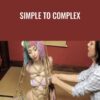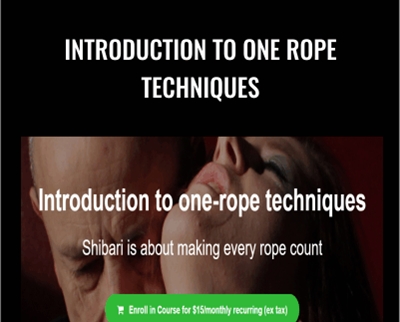$150.00 Original price was: $150.00.$43.00Current price is: $43.00.
This tutorial is a perfect introduction to shibari but will also be a great help to more experienced players wanting to explore one-rope techniques. I’m sticking with ‘one-rope’ as there is endless argument over the Japanese terms.
 Purchase this course you will earn 43 Points worth of $4.30
Purchase this course you will earn 43 Points worth of $4.30Introduction to one-rope techniques
Shibari is about making every rope count
This tutorial is a perfect introduction to shibari but will also be a great help to more experienced players wanting to explore one-rope techniques. I’m sticking with ‘one-rope’ as there is endless argument over the Japanese terms. ‘Ippon nawa’ is the technically correct literal translation, although ‘ichinawa’, an incorrect translation, seems to have been coined along the way. A rose by any other name doth smell as sweet but I’ll stick with English
By using a single rope, we makes things simple but will also learn how to create the maximum effect. If you don't already know how powerful one rope used well can be, prepare to be surprised.
We start from the beginning by discussing the tools of the job, showing how to handle them properly, explaining the basic ‘ingredients’ needed to start creating ‘rope recipes’ and sharing a lot of pro tips learned directly from masters of the art like Osada Steve and Yukimura Haruki. Of course, having preached 'tying people, not parcels' since before most westerners had even heard of shibari, you will benefit from a wealth of experience.
In this course, we have taken a slightly different approach by working with a student and her model. A lot of you will recognise Bliss as a prolific shibari model who has been tied by some of the best. However, this lesson is her début into tying others, although she has done some self tying. There’s no doubt that her experience as a model has taught her a lot about how experts communicate with rope. Her first attempt at a floor-work session is certainly demonstrates this. I am sure you’ll learn some tricks from her.
You will gain an insight into our own special way of teaching ingredients, rather than the more common ‘paint by numbers’ recipe-based approach. We have found that this leads to a faster grasp of the principals of building ties and a greater ability to spot one’s own mistakes, so tying more with more confidence to be creative. By developing the right habits and techniques day one, your rope will begin to have an immediate effect. Learning these skills later is much harder as you have to unlearn bad habits. It just wastes too much time and, most importantly, potential pleasure. We believe that every rope should make an impression and say something.
The video tutorials run to over 90 minutes following Bliss’s journey of learning. There’s very little edited from our class (except the likes of the blooper below), so typical beginner’s mistakes and problems are covered in great detail with my corrections and advice. If you are thinking of coming for a private class, it will give you an idea of what to expect, except I can guarantee more input from Nina when she isn’t busy being cameraman and director.
In addition, you'll find examples of one-rope sessions, resources for further studies and explanatory notes.
Get Introduction To One Rope Techniques – Bruce Esinem, Only Price $47
Course Curriculum
Introduction to one-rope techniques
- Introduction (7:19)
- Ichinawa or ippon nawa?
- The basic ingredients (16:49)
- Taking control (5:19)t
- Communicating with rope (19:10)
- Control via the rope ends (5:59)
- Self-practice exercise (3:05)
- Getting more from one rope (6:58)
- Mixing the ingredients (21:21)
- First floor-work session (13:44)
- Summary (3:24)
- 'Ask Esinem' Q&A forum
Additional material
- The four stages of learning
- Yukimura Haruki videos
- Osada Steve video
Get Introduction To One Rope Techniques – Bruce Esinem, Only Price $47
Tag: Introduction To One Rope Techniques – Bruce Esinem Review. Introduction To One Rope Techniques – Bruce Esinem download. Introduction To One Rope Techniques – Bruce Esinem discount.
Only logged in customers who have purchased this product may leave a review.
Related products
Uncategorized
= 85 Points
= 84 Points
= 94 Points
Uncategorized
Cognitive Rehabilitation Therapy: Practical Interventions and Personalized Planning – Jane Yakel
= 85 Points
Uncategorized
= 85 Points
Uncategorized
Disordered Eating Behaviors: Identify and Treat the Underlying Trauma – Lori Kucharski
= 85 Points
Uncategorized
= 35 Points
Uncategorized
Legal Risks in Nursing Documentation – Use Extreme Caution When Skimming the Facts – Rosale Lobo
= 40 Points





Reviews
There are no reviews yet.